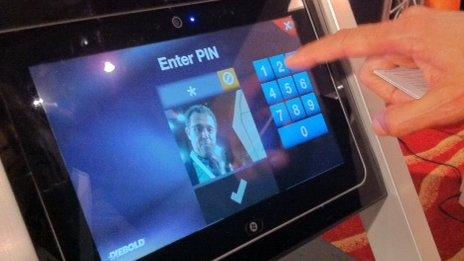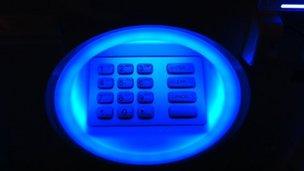Tablet cash machines: The ATM of the future?
- Published

Keypads on screen and video cameras are among the latest features
There are 66,134 cash machines in operation across the UK - an all-time high - yet they have changed little since they first appeared on the High Street in 1967.
As payment methods move digital, so cash machines will need to develop from the terminals that we have all become used to, experts say.
The main challenge comes from the smartphone. Mobile banking allows customers to check balances, organise transfers, make swift payments between friends in restaurants or pay the local tradesman.
The answer from the industry, it appears, is to make the cash machine more like a smartphone.
A recent cash machine jamboree in London featured a host of prototype terminals that had the look, and feel, of oversized smartphones or tablet computers.
Emergency cash
Security and software company Diebold has created a new cash machine that uses the standard technology of a tablet computer.
It is two-thirds of the size of a traditional cash machine, uses touch screen keypads, and just plugs in using a broadband connection. This means it can be used in more places and moved around to suit customers.
A camera allows users to see what is happening behind them, for personal safety reasons, and may even catch fraudsters in the act on video.
Facial recognition can match an individual with their account and the screen can link to their smartphone.
This will allow users to organise their cash withdrawal in advance, or allow parents to give their children a code for emergency cash while they are on holiday or away at college.
Brahim Kessaci, of Diebold, says the machine is still in demonstration stage at present, but could be placed in bank branches or shops in the future.
All this is a clear departure from the wonky screens and grubby keypads that have become a common sight on the UK High Street.
The cash machine remains the primary source of getting banknotes into our wallets and purses, but must evolve, the industry says.
In the days of instant internet access, it is not good enough for a machine to ask people to "please wait a moment" while their cash is being dispensed, according to Reinhard Rabenstein, chief technology officer at Wincor Nixdorf.
That is why the new breed of cash machines are slicker and smarter - just like mobile phones.
'Cash and dash'
Mr Rabenstein's company's new model displays a customer's personal "profile" when their card goes into the slot. It shows their favourite transactions, local services and a selection of options that suit their account.
For example, if a customer always takes out £50 when he or she goes to the machine, then that option will be prominent on the screen.
The incentive for banks is that machines can reduce the queues at counters, allowing staff to sell more products rather than just process payments.
The cash machine is moving on from "cash and dash", as the industry jargon describes it, to a more personal service.
That can have benefits for consumers too. Live link video screens will give them the opportunity to talk to customer services staff at any time of day, instead of just normal opening hours. Drive-through cash machines, as seen in the US, will mean drivers will not even have to leave their vehicle to use the machine.
Moving machines will be able to lower to the level of a wheelchair when they recognise the need. People with disabilities have long argued that cash machines are often inaccessible for them.
Elderly people also struggle with fiddly buttons, screens that are hard to read, and the four-digit Pin code, according to a report for the Payments Council, external, published in October last year.

The cashless cash machine is designed to be used in low-footfall areas
As a result, some elderly and disabled people have been sharing passwords, card details and Pin numbers with family and friends because they are struggling to access cash.
The report also raises the issue of rural customers finding that many machines regularly run out of cash.
Aravinda Korala, chief executive of KAL, says the answer to this conundrum is the cashless cash machine.
His business is promoting a machine that is located in a shop or Post Office. Instead of relying on the bank refilling the machine, it delivers a voucher which can then be redeemed for cash at the store's till.
Global change
Cash machine designers are upgrading their own technology, but they are also looking to new markets.
Wincor Nixdorf has created its own app store to try to tap into the mobile payments sector.
It is also focusing its efforts on the global market. Emerging economies are seeing a rapid increase in banknote use, according to Mr Rabenstein.

The keypad is lit up in different colours on the Halo cash machine
It also wants to become the cash agent that allows people in developing countries to convert airtime on their mobile phones to currency to spend.
In the meantime, cash remains king in the UK. The cash machine network is still growing, so that means competition among designers remains fierce.
"There is little doubt that the increased use of mobiles and smartphones for such things as day-to-day banking and paying bills is likely to have an impact on the use of ATMs by some people," says Mark Hemingway, of the Payments Council - a body that oversees UK payments strategy.
"However, we still expect that by 2021, cash machines will still dispense around 80% of all the cash used in the UK."
So, if lots of people are going to keep using them, then they might at least look a bit more trendy.
Enter the Halo machine, from Nautilus Hyosung. Its distinctive feature is a keypad that lights up in lots of different colours.
Maybe this will finally put the swing into an invention from the 1960s.